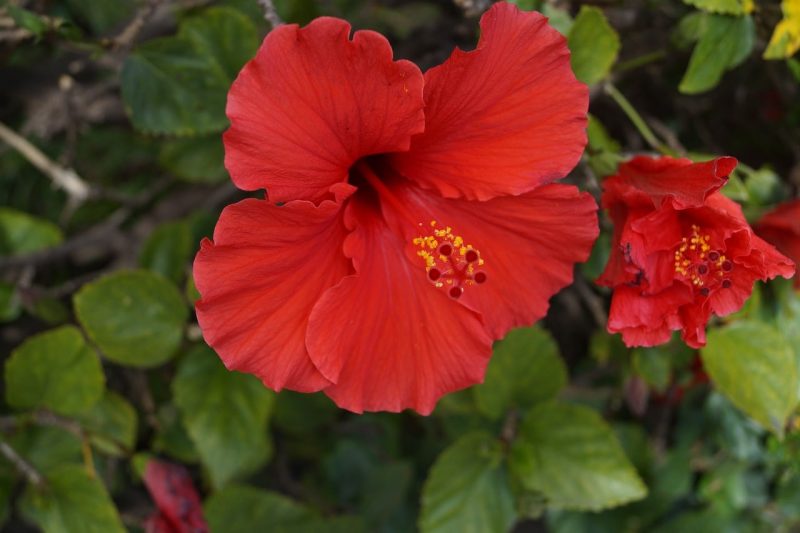If you want to know how to grow hibiscus from cuttings, you’ll be pleased that it is as simple as three steps. You can always grow hibiscus from seeds, but propagating from cuttings is quicker and less demanding. However, both processes would be comfortable in the greenhouse if you want them to root without drawbacks for easier transplanting later on.
According to the University of Minnesota Extension, hibiscus plants are generally easy to grow. Therefore, you shouldn’t feel intimidated to start these plants from cuttings. Being thorough with the tips below should ensure rooting and establishment in no time.

How To Grow Hibiscus From Cuttings For Success
Step #1. Taking cuttings
The first step is choosing the parent plant that will be your source of cuttings. Remember that you must select a healthy plant, and the cuttings themselves are free of any diseases and damages. You can also grow your favorite hibiscus varieties in the greenhouse to ensure that they are stress-free for cutting collection.
Once you’ve chosen the parent plant and a stem of new growth or softwood, you can cut a 5-inch section with at least one node below a node. It might also be better to prepare the containers beforehand so your cuttings won’t have to wait for a long time. After all, the best time to plant the sections is immediately after collection.
You can use any container as long as it has good drainage, and a common medium that gardeners use for hibiscus is a mix of sand and peat. It would be best if you moistened this medium as well before planting. After you have the containers with medium ready, you can take the cuttings in spring or early summer for softwood sections.
Step #2. Preparation and planting
Before planting, make sure that you have removed all the leaves on your cuttings except those at the top. You can also trim the section’s bottom part below the leaf node. And like when preparing cuttings of most plants, you can dip the end in rooting hormone to hasten the root development.
The best time to plant the cuttings is during spring, but you can also do it any time as long as you notice new growth. Stick the cutting into the medium and then backfill the space to support its stability. You may also find it easier to plant by sticking a finger in the middle of the pot as a guide to where you’ll place the cutting.
Step #3. Maintenance and transplanting
Hibiscus cuttings can start forming roots within four to five weeks. However, proper maintenance should help you grow as fast as possible. As mentioned earlier, the moist medium is essential to help the cuttings develop.
You can conserve moisture further by covering the pot with a plastic bag, but make sure that it won’t come in contact with the leaves. Place them somewhere with partial shade or inside the greenhouse to protect from fluctuating conditions. The maintenance you have to do is keeping the soil damp until they develop roots.
You can repot the hibiscus plants when they rooted and provide diffused light on the plants to encourage growth further. It would help if you acclimated the hibiscus in the outdoor conditions first before you transplant them in the garden. Lastly, wait for new development and transplant the plants permanently in containers or the garden.
Caring For Hibiscus
Location
As mentioned earlier, growing hibiscus in the greenhouse is useful if you want to ensure stable conditions. Remember that anything below 32°F will be problematic, and the best range for these plants is from 60 to 90°F. Freezing conditions would require you to use a greenhouse to protect hibiscus.
The location itself should have full sunlight for better blooms. You can test the soil as well to check for its quality and fertility. And lastly, amend the ground to help it have better drainage using peat moss or compost.
Water and fertilizer
Like most plants, adjust the amount and frequency of watering on your hibiscus plants depending on the climate. Remember that overwatering can kill hibiscus, but you must also water them well, especially during blooming. Those in containers should also receive more water.
On the other hand, a high potassium fertilizer during the summer would help the blooms of your plants. As for maintenance, some gardeners provide feedings once a month. You may also boost your plants with a liquid fertilizer once a week.
Common problems
According to the University of Florida, the common pests you might encounter in growing hibiscus are aphids, mealybugs, and whiteflies. Always monitor your plants to address these insects as soon as possible to make population control easier. You can use horticultural oils to handle the pests, but be mindful of the pesticides you’ll use for more massive infestations.
Conclusion
There are different ways to propagate hibiscus, but using cuttings might be the most convenient for those with existing plants. You can quickly learn how to grow hibiscus from cuttings in three steps, and those who have experience rooting other plants from cuttings should have no issues applying the same techniques. Choose a healthy parent plant and cut disease-free sections as you would with other plants.
Remove the leaves except those at the top and dip the end of the section in the rooting hormone. Stick it in a moist medium and cover the pot with plastic until roots develop. You can also place the hibiscus cuttings inside the greenhouse to ensure stable conditions for quicker growth.
